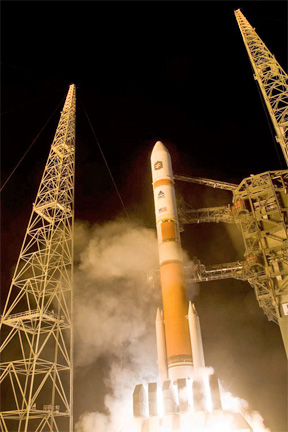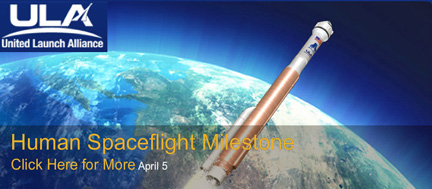...thorough flight clearance process that was executed following a flight data anomaly that occurred on the Global Positioning System (GPS) IIF-3 launch on October 4, 2012.
"This will be the first Delta IV launch following the low engine performance that was identified on the successful Global Positioning System (GPS) IIF-3 launch last October," said Jim Sponnick, ULA vice president, Mission Operations. "Although the GPS IIF-3 spacecraft was accurately placed into the required orbit, ULA, Pratt & Whitney Rocketdyne (PWR) and our U.S. Air Force teammates embarked on an investigation to determine why the upper stage engine performance was lower than expected. ULA completed a flight clearance assessment recently for the WGS-5 mission and our Air Force customer also assessed and

WGS-3 launches aboard a ULA Delta IV in 2009—photo courtesy of Pat Corkery/ULA.
"I thank our customer community and senior technical advisors for working with us throughout this very extensive investigation and flight clearance process," said Sponnick. "Given the comprehensive investigation that included extensive analyses and engine testing, along with the mitigating actions that have been implemented, we have concluded that the risks have been mitigated and that it is safe to proceed with the WGS-5 launch."
Engine testing that was performed to support this ULA investigation replicated fuel leaks like those observed in the GPS IIF-3 launch. The mitigations that have been implemented include extensive engine and launch-vehicle inspections to ensure that there is no damage and that there are no foreign objects that could cause problems for the operation of the engine system during launch. Additionally, launch vehicle hardware modifications and operational changes have been implemented to mitigate risks for the WGS-5 mission and future launches. The hardware modifications include the addition of in-flight helium purges to critical areas of the engine system. The operational changes to reduce risk include changes to how the engine is thermally conditioned in-flight to prepare for the first engine start following the booster phase of flight.
ULA program management, engineering, test, and mission support functions are headquartered in Denver, Colorado. Manufacturing, assembly and integration operations are located at Decatur, Alabama, and Harlingen, Texas. Launch operations are located at Cape Canaveral AFS, Florida, and Vandenberg AFB, California.


